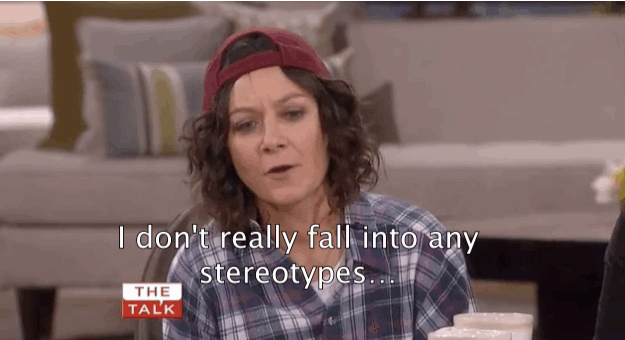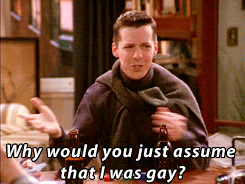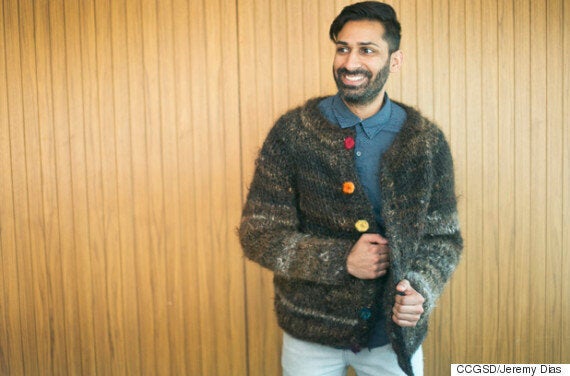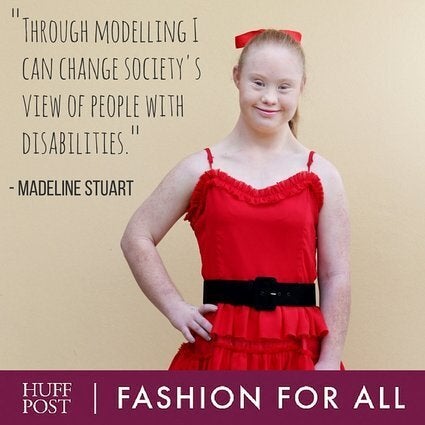Although the fashion industry has come a long way in terms of diversity and has embraces blurring gender boundaries, there are still plenty of commonly-held beliefs involving LGBTQ communities and fashion.
These stereotypes tend to look like this for gay women:

and this for gay men:

Some embrace stereotypes, but for many, the cliches don't match who they are at all. Stereotypes about lesbians are often statistically unfounded and no, not all gay men listen to Macklemore.
Being pigeonholed can be a source of routine annoyance, but it can also have adverse consequences in the workplace. An American study shows that more than 42 per cent of gay employees say they have experienced discrimination on the basis of their identity, and the stat climbs to 90 per cent for trans employees.
We asked queer and trans Canadians working in fashion about some of the enduring stereotypes they encounter:
The Stereotype Of The Gay Male Designer

If you think fierce is the only word in Patrick Salonga's vocabulary, think again.
Salonga, 25, is a gay fashion designer whose work has strutted down Toronto Men's Fashion Week. He's observed how the industry typecasts male designers as gay until proven otherwise. In doing so, it's also upheld certain traits associated with gay designers.
"If you are a gay man in fashion ... you are very snooty and rude," Salonga told HuffPost Canada Style. "You think too highly of yourself and your key word is probably 'fierce.'"
While gay men have greatly influenced high fashion, the belief that they are the majority has led some to blame gay designers for the industry's woes.
Kanye West may have claimed not being gay prevented him for succeeding in fashion, but there are no statistics that prove the fashion industry is made up of only gay designers.
Salonga hasn't experienced any discrimination in his profession, but thinks it's still an enduring problem.
"I feel like realistically stereotypes are gonna be here for a long time, sadly," Salonga says. "All we can do is keep talking about it and keep educating everyone. It might not be completely gone, but hopefully it'll get way better."
...And The Stereotype of the Lesbian Fashion Designer
Mina Smart designs women's outerwear and latex lingerie as half of House of Etiquette, which she runs with her partner.
Smart, 30, is a trans woman. She knows that people assume that just because the couple dresses femininely, they can't be lesbians.
"I feel like the 'all Lesbians have no fashion sense' or 'all lesbians are butch, or masculine presenting' are pretty present in fashion (and elsewhere)," Smart says. "I think that stereotypes are hurtful, and affect people’s preconceptions... these stereotypes can cause lesbian women to be overlooked as potential designers."
You Are Not What You Wear
Contrary to belief, sashaying and glitter does not a queer make.
Gay men and lesbians living in cities no longer wear colour-coded handkerchiefs to signal kinks, but that hasn't stopped certain aesthetic looks from being associated with sexuality.
TJ Jans, who was the first transgender model to walk Western Canada Fashion Week, says stereotypes about how queer women dress are still popular.
"The classic stereotypes regarding lesbians, that they are very butch, wear lots of plaids, baggy clothes, and Birkenstocks still hangs on," Jans tells HuffPost Canada Style. "People tend to forget that there are also femmes, who prefer to wear makeup and dresses."
Fashion blogger Stephen-Thomas Maciejowski says he has seen trends come and go without blinking an eye, but was taken aback the first time he saw men wearing high heels in a fashion show.
He's since realized that it was okay for anyone to wear anything. Instead of judging people for blurring which gender wears what, he reminds himself that society conditions people to only accept gender fashion norms.
"Now I say whatever, they want to be tall," Maciejowski says. "They’re having fun and they like the way they look."
Myth: Gender Presentation = Gender Identity
Jans, who uses the gender-neutral pronouns they, them, and their, says that verbal harassment happens constantly for people who challenge gendered clothing.
"When I was still identifying as a woman, but also wearing masculine clothing, I often had people glare or yell profanities at me," they says. "I've had more than one incident where a truck or car full of men followed me yelling threats."
Jans also takes issue with how drag culture, popularized by cisgender men in RuPaul's Drag Race, has been misunderstood as a transgender issue. In reality, drag queens and drag kings who don on bombastic personas do not identify as their gender performance.
"Transgender people are not performing their gender, they are their gender and generally they wear clothes they feel fit the gender they are," Jans says.
One trans woman of colour feels the same way. She notices that drag performers get more attention and paying work than trans individuals.
Xav is a 24-year-old model with Lorde Inc., a modelling agency devoted to diverse representation in the fashion industry. Xav, who goes by one name, says that before she came out as trans, her superiors in different agencies would call her out on being "sissy," "girly," and "effeminate."
"Some people would say it in a joking way, but there's that undertone to everything," Xav tells HuffPost Canada Style. "There's what you say and what people feel it."
In her line of work, Xav says that being trans means her body image will often be presented an androgynous manner by those who hired her. They would mix masculine and feminine clothing items and makeup choices.
"Because I don't have breasts and I have not started doing hormone therapy, they would want me to look androgynous," Xav says.
You Cannot Tell Someone Is LGBTQ By How They Act
Stevo Trann, a 26-year-old model from Montreal, says that most people have to ask if he's gay. Describing himself and co-workers as simple and down-to-earth, he says those who ask him about his orientation probably buy into the myth that most queer men act flamboyantly.
"I just think people have to keep in mind that we are in 2016. I don't feel like I have to make a statement being gay," Trann tells HuffPost Canada Style. "This is who I am and I love the way I am."
Clothes Cannot Be Gay ... Except For This Sweater

Clothing can’t be gay. Even the group behind the Gay Sweater agree.
The word "gay" has long been used as a negative descriptor for anything or anyone. The consequence of hearing one's identity used as a catch-all term for anything horrible can be harmful. A University of Michigan study shows that the phrase "That’s so gay" can negatively impact the health of lesbian, gay, and bisexual college students, resulting in lose of appetite and increased isolation.
Enter the gay sweater. Woven with hair from more than 250 gay Canadians, the sweater one of the few articles of clothing that is literally gay. Jeremy Dias from the Canadian Centre for Gender and Sexual Diversity is touring classrooms nationwide with the sweater, using it as a tool to teach children about LGBT acceptance. He remembers many reactions to the hairy sweater, ranging from curiosity to disgust, but one in particular spoke to him.
"One child, he was wearing the sweater ... he interrupted the group in the middle of their presentation, saying he 'didn’t feel it anymore,'" Dias tells HuffPost Canada Style.
For Dias, that was exactly the point.
"The longer you wear it, the more you get used to it. That is literally what homophobia feels like," Dias says. "The more that you hear 'That’s so gay, he’s such a fag' … that’s part of our daily reality. It’s a complicated negotiation of violence and pain."
Also on HuffPost
